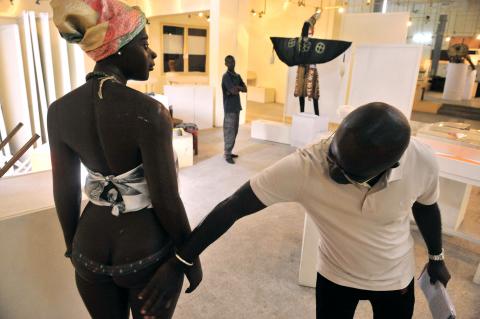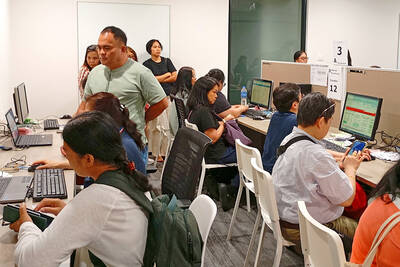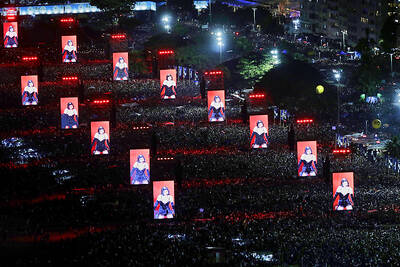Bullet holes pock the vault door and empty display boxes litter the showroom floor of Abidjan’s Museum of Civilization, robbed of 100 ancient artifacts under the cover of deadly conflict in April.
“A piece of our history has been wiped out,” museum director Silvie Memel Kassi said of the collection’s lost crown jewels, some dating back to the 17th century, that may now be melted for the gold.
“It is a huge loss,” she said.

Photo: AFP
Worth an estimated 3 billion CFA francs (US$6.5 million), but irreplaceable, the looters made off with masks, sabers, crowns and gold-handled fly swatters — objects described by the museum as “authentic, unique and rare.”
“I had dreamed of leaving a museum of reference for future generations,” Zoko Djowa, the museum’s curator for the past 30 years and just months from retirement, said bitterly as he walked around the devastation.
Opened by the then-French administration in a white, colonial-style building in 1942, the museum could not have been worse placed during the conflict that engulfed Ivory Coast’s economic capital after a disputed election in November last year.
In Plateau, the neighborhood housing the presidential palace, the building also borders Camp Gallieni army headquarters and came under fire from both sides to the four-month conflict.
Fighting ended on April 11 with the arrest of former Ivorian president Laurent Gbagbo, who sparked the conflict by refusing to concede defeat to now-President Alassane Ouattara.
Shelling left a large hole in the museum facade.
Inside, the shattered state of the exhibition hall would break the heart of any art lover hoping to see the once rich collection of artifacts telling the story of the peoples of Ivory Coast.
Bullet marks have been left on the double glass that used to enclose sabers used by the royal Agni people from the east of the country.
Glass display boxes lie strewn on the floor, empty.
In the middle of the room; the massive, hundred-year-old skeleton of an elephant — the national emblem — towers over the few masks and statuettes left of the once proud collection.
Among the items lost: pendants worn by the central Baule people in the seventeenth century, statuettes of the western We and northern Senufo tribes, crowns and fly swatters with solid gold handles from the central and coastal regions, and sacred masks from the Dan people in the west.
While the pillagers failed to reach most of the estimated 11,000 items locked up in vaults, they did make off with the museum’s flagship collection.
“All of Ivory Coast” was exhibited there, Memel Kassi said in her small office, surrounded by traditional masks.
Each of the stolen objects “taught us something about its culture, its civilization, its beliefs,” she said.
Without holding out much hope, the museum has issued a search notice for the plundered items through the cross-border policing organization Interpol and urged the public to help.
However, chances of recovering the items are slim, said Jules-Evariste Toa, a communication professor at the University of Abidjan.
“One can melt the gold or start a private collection. We fear never to see the items again,” the once-regular museum visitor said.
Now closed to the public, the museum — which has seen its visitor numbers dwindle in recent years — will have to stretch its meager 76,000 euro (US$109,000) budget to cover vital refurbishment and security improvements.
“We need an alarm system and weapons,” museum security guard Jean-Claude Agniman said.
However, by far the worst consequence of the looting, Ivorians say, is the loss of patrimony invaluable to helping forge a common national identity as the nation embarks on reconstruction after a decade of crises and tensions.
“Ivory Coast is losing its points of reference with the disappearance of these pieces,” said Ivorian poet and writer Paul Ahizi, describing the theft as “a desecration of the spirit of [our] ancestors.”
“The country will have a problem defining its own identity and spirituality,” he said.

Kehinde Sanni spends his days smoothing out dents and repainting scratched bumpers in a modest autobody shop in Lagos. He has never left Nigeria, yet he speaks glowingly of Burkina Faso military leader Ibrahim Traore. “Nigeria needs someone like Ibrahim Traore of Burkina Faso. He is doing well for his country,” Sanni said. His admiration is shaped by a steady stream of viral videos, memes and social media posts — many misleading or outright false — portraying Traore as a fearless reformer who defied Western powers and reclaimed his country’s dignity. The Burkinabe strongman swept into power following a coup in September 2022

A new online voting system aimed at boosting turnout among the Philippines’ millions of overseas workers ahead of Monday’s mid-term elections has been marked by confusion and fears of disenfranchisement. Thousands of overseas Filipino workers have already cast their ballots in the race dominated by a bitter feud between President Ferdinand Marcos Jr and his impeached vice president, Sara Duterte. While official turnout figures are not yet publicly available, data from the Philippine Commission on Elections (COMELEC) showed that at least 134,000 of the 1.22 million registered overseas voters have signed up for the new online system, which opened on April 13. However,

‘FRAGMENTING’: British politics have for a long time been dominated by the Labor Party and the Tories, but polls suggest that Reform now poses a significant challenge Hard-right upstarts Reform UK snatched a parliamentary seat from British Prime Minister Keir Starmer’s Labor Party yesterday in local elections that dealt a blow to the UK’s two establishment parties. Reform, led by anti-immigrant firebrand Nigel Farage, won the by-election in Runcorn and Helsby in northwest England by just six votes, as it picked up gains in other localities, including one mayoralty. The group’s strong showing continues momentum it built up at last year’s general election and appears to confirm a trend that the UK is entering an era of multi-party politics. “For the movement, for the party it’s a very, very big

ENTERTAINMENT: Rio officials have a history of organizing massive concerts on Copacabana Beach, with Madonna’s show drawing about 1.6 million fans last year Lady Gaga on Saturday night gave a free concert in front of 2 million fans who poured onto Copacabana Beach in Rio de Janeiro for the biggest show of her career. “Tonight, we’re making history... Thank you for making history with me,” Lady Gaga told a screaming crowd. The Mother Monster, as she is known, started the show at about 10:10pm local time with her 2011 song Bloody Mary. Cries of joy rose from the tightly packed fans who sang and danced shoulder-to-shoulder on the vast stretch of sand. Concert organizers said 2.1 million people attended the show. Lady Gaga